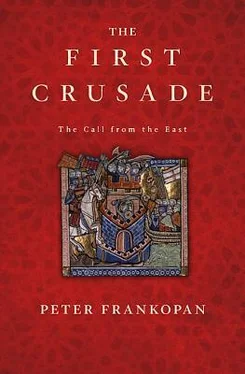As we have seen, Bohemond, keen to hold Antioch for himself, had remained impervious to the wishes of the other leaders and the rank and file who wanted to move on Jerusalem. When the Crusaders met in the Basilica of St Peter in Antioch to try to reach a compromise, Raymond of Toulouse calmly dismissed accusations that the commitments given to Alexios were void, repeating the words of the oaths that had been given to the emperor. 62He reminded everyone of what had been said: ‘We swore upon the Cross of the Lord, the crown of thorns and many holy relics that we would not hold without the consent of the emperor any city or castle in his dominion.’ 63
It is tempting to see the arguments about the oaths given to Alexios as turning exclusively on definitions of fealty and on the moral rectitude of those like Raymond, who considered themselves to be bound by their vows, and those like Bohemond, who did not. While clearly there were important legal implications to what had been agreed with the emperor, there were also practical issues underpinning the arguments between the Crusade leaders themselves. The positioning of the various leaders relative to each other was of course a factor in the refusal of the Count of Toulouse to let Bohemond have free rein to take Antioch for himself; it was not simply that the former wanted to respect the oaths given to Alexios, but also that he did not want to countenance one of his peers – and rivals – gaining an undue upper hand. In that respect, the oaths given to the emperor were a useful shield to hide behind – offering Raymond the chance to attack Bohemond while retaining the high ground.
From the Byzantine perspective too, the practical reality of the situation in Antioch and beyond was complex and subtle, and required a more nuanced approach than recourse to high-level notions of what exactly bonds of fealty meant. There can be no doubt that Alexios knew exactly what he was doing when he insisted on commitments being given to him in a format and manner that he knew would be understood by the principal leaders of the Crusade. But his main priority, at least in 1096 and early 1097, was ensuring that the passage of the expedition was trouble-free as it passed Constantinople at a time when the emperor’s hold on power was precarious. As it happened, the promises he extracted became very useful as time went on, offering Alexios the opportunity to claim that he had been wronged by individual leaders and by the Crusade as a whole.
But within this mix of accusation and counter-accusation, and what would seem to be rather arcane arguments about agreements being void (or otherwise), it became important for Bohemond to be able to demonstrate simply and clearly just how he came to hold Antioch in the face of claims from Byzantium and indeed from some Crusaders too that he had no right to do so. It was this political imperative that underpinned attitudes towards the emperor which circulated through Europe at the start of the twelfth century. Thus, while some effort was made by chroniclers writing in the early twelfth century to demonsrate that Alexios had not fulfilled his commitments to the expedition’s leaders, a great deal more went into mounting a full-scale character assassination of the emperor Alexios.
The real damage to the emperor’s reputation was not done by the Gesta Francorum and by the chronicle of Raymond of Aguilers, but by a string of accounts composed around the time that Bohemond began to recruit men for the expedition against Byzantium, after his return to Italy at the end of 1104. Histories of the Crusade written by Robert the Monk, Baldric of Dol and Guibert of Nogent in or soon after 1107 all made extensive use of the Gesta Francorum , faithfully repeating the negative portrayal of the emperor. The delight Alexios was purported to have felt at the massacre of the People’s Crusade in 1096 was dutifully reported by all three. 64Paraphrasing the Gesta , they stated coldly that the emperor did not advance to Antioch because he was a coward. 65
Yet these authors went further than simply repeating and paraphrasing the Gesta , for they all elaborated on Alexios’ supposed shortcomings and faults. Guibert of Nogent was especially creative. The emperor’s mother, he wrote, was a sorceress with a firm command of the dark arts. Alexios, furthermore, was so iniquitous that he issued a proclamation by which families with more than one daughter had to give one girl up to be a prostitute; money raised from the sale of her services helped fund the imperial treasuries. He ordered families with more than one son to offer one up for castration. With so many young men deprived of their virility, little wonder Alexios had needed help from the west, wrote Guibert. 66
Such outlandish charges were gleefully circulated and added to by historians writing in the twelfth century and later. One such history stated that Alexios was only able to defeat Robert Guiscard in 1085 because he told the Norman’s wife that he would marry her if she poisoned her husband, which she duly did. 67This was embroidered by others, like Roger of Hoveden, who stated that Alexios did indeed marry Sickelgaita, only to burn her alive after having her crowned as his empress. 68
The hostility towards Alexios intensified rapidly in the early twelfth century. He was a man, said William of Malmesbury, who was ‘better known for treachery and his cunning than for honest dealing’. 69William of Tyre, writing several decades later, summed up how the emperor was seen in the Latin East. Alexios could not be trusted, wrote the archbishop; he was ‘like a scorpion; for while you have nothing to fear from its face, you do well to avoid injury from its tail’. 70
This view was perpetuated over the centuries. In the eighteenth century, Edward Gibbon, for example, followed the medieval caricature closely. ‘I should compare the emperor Alexius’, he wrote, ‘to the jackal, who is said to follow the steps of and devour the leavings of the lion.’ Even the empress Eirene, he claimed, thought little of her husband, sharing the opinions of others. After the emperor died, therefore, she insisted that an epitaph be inscribed on Alexios’ tomb saying: ‘You die, as you lived – an hypocrite.’ 71
The reputation of the emperor Alexios has never recovered and his vilification has had a wider impact in shaping interpretations of the First Crusade. The emperor has been barely visible in accounts of the expedition to Jerusalem, particularly of its origins, because he was airbrushed from history in the wake of the disputes at Antioch. Deliberately set to one side by Latin historians at the time, Alexios has remained on the periphery ever since – merely an incidental player in the campaign.
If anything, Alexios’ success at Diabolis in 1108 only served to reinforce this image, as western historians strove to undermine his claims as to what were now seen as legitimate Crusader possessions – above all Antioch. As it happened, Bohemond never returned to the city to take up his new ‘appointment’, which meant that imperial authority over Antioch remained notional. Envoys sent by the emperor to Tancred to enforce the terms reached at Diabolis were given short thrift; the Norman refused to accept the emperor’s demands, assuring his ambassadors that he would never release his grip on Antioch even if his adversaries came at him with hands of fire. 72
When Bohemond died in 1111 possession of Antioch should have passed to Byzantium, as set out in the treaty. But his death came at an inopportune moment for the emperor, for as long as Bohemond was alive there was hope that he would exert influence over Tancred. Now Alexios had little opportunity to make political capital out of the terms reached with Bohemond – or indeed use the resulting settlement as a corrective to the inflammatory statements made in the early Crusade chronicles.
Читать дальше











